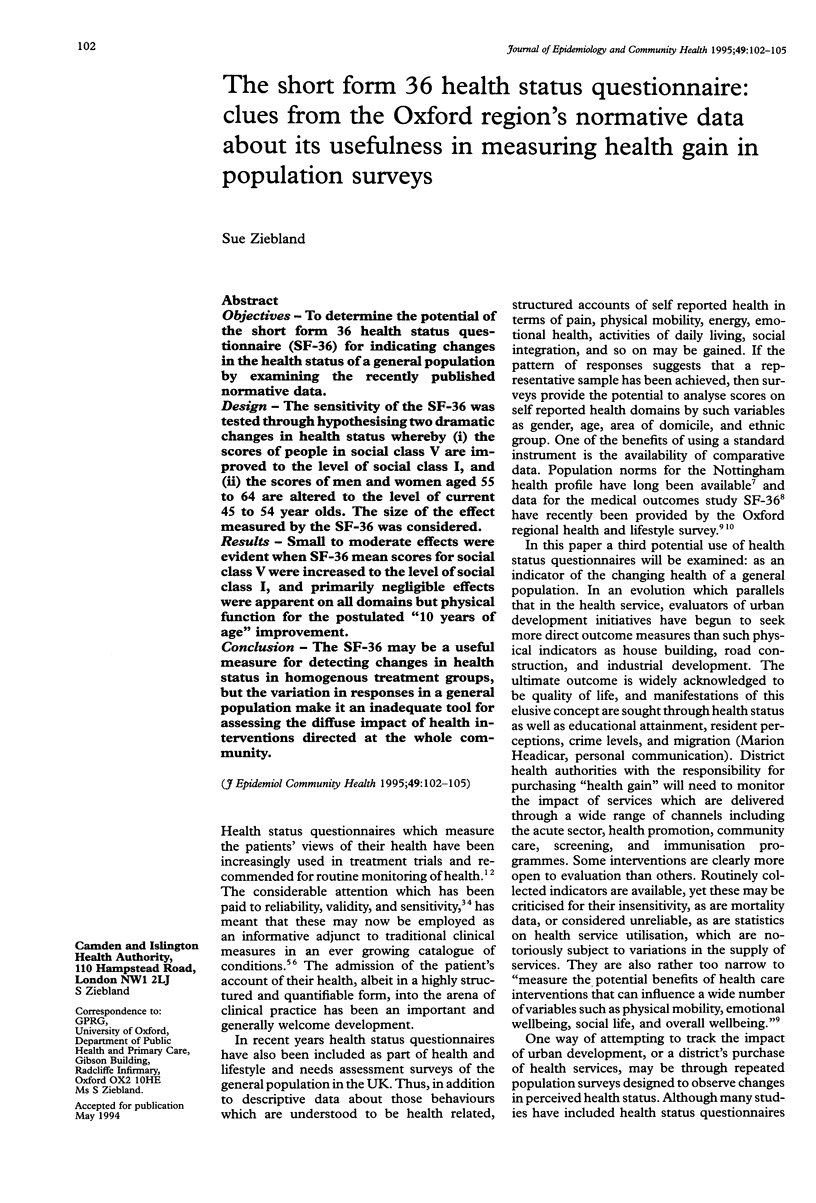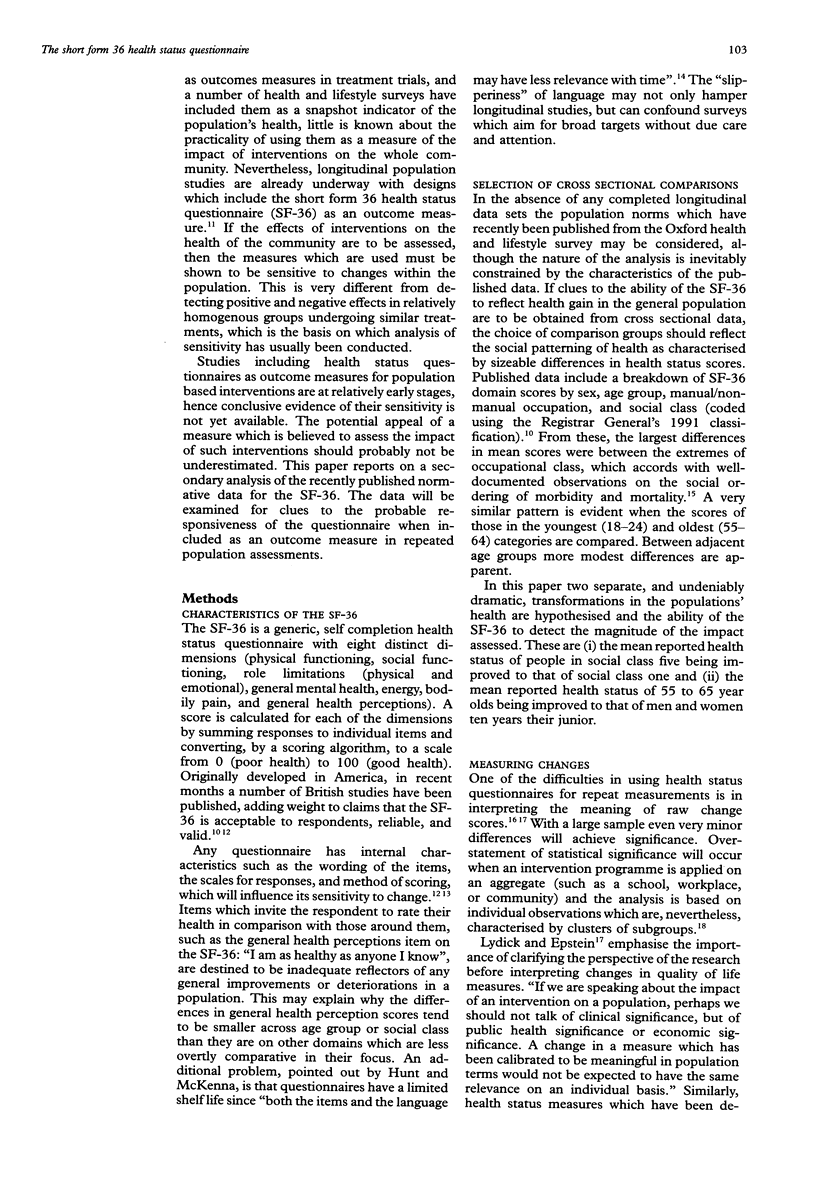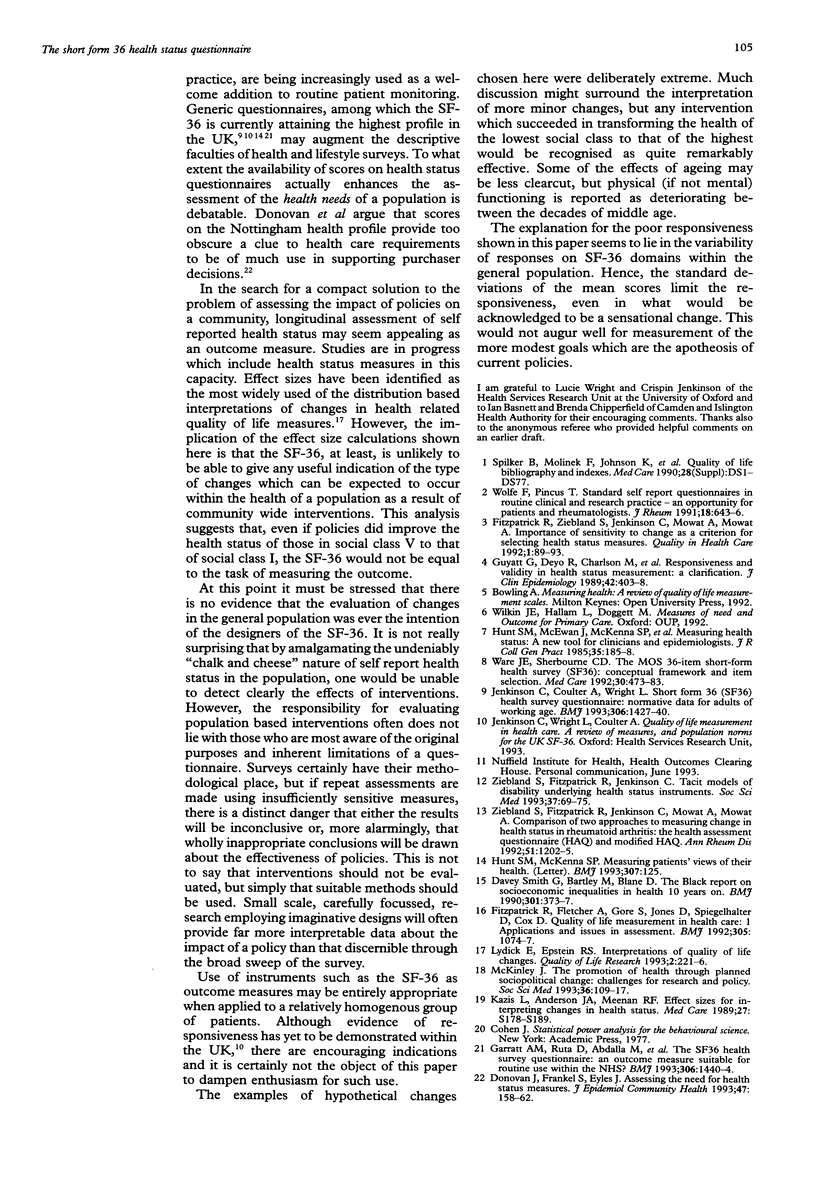Abstract
OBJECTIVES--To determine the potential of the short form 36 health status questionnaire (SF-36) for indicating changes in the health status of a general population by examining the recently published normative data. DESIGN--The sensitivity of the SF-36 was tested through hypothesising two dramatic changes in health status whereby (i) the scores of people in social class V are improved to the level of social class I, and (ii) the scores of men and women aged 55 to 64 are altered to the level of current 45 to 54 year olds. The size of the effect measured by the SF-36 was considered. RESULTS--Small to moderate effects were evident when SF-36 mean scores for social class V were increased to the level of social class I, and primarily negligible effects were apparent on all domains but physical function for the postulated "10 years of age" improvement. CONCLUSION--The SF-36 may be a useful measure for detecting changes in health status in homogenous treatment groups, but the variation in responses in a general population make it an inadequate tool for assessing the diffuse impact of health interventions directed at the whole community.
Full text
PDF



Selected References
These references are in PubMed. This may not be the complete list of references from this article.
- Donovan J. L., Frankel S. J., Eyles J. D. Assessing the need for health status measures. J Epidemiol Community Health. 1993 Apr;47(2):158–162. doi: 10.1136/jech.47.2.158. [DOI] [PMC free article] [PubMed] [Google Scholar]
- Fitzpatrick R., Fletcher A., Gore S., Jones D., Spiegelhalter D., Cox D. Quality of life measures in health care. I: Applications and issues in assessment. BMJ. 1992 Oct 31;305(6861):1074–1077. doi: 10.1136/bmj.305.6861.1074. [DOI] [PMC free article] [PubMed] [Google Scholar]
- Fitzpatrick R., Ziebland S., Jenkinson C., Mowat A., Mowat A. Importance of sensitivity to change as a criterion for selecting health status measures. Qual Health Care. 1992 Jun;1(2):89–93. doi: 10.1136/qshc.1.2.89. [DOI] [PMC free article] [PubMed] [Google Scholar]
- Garratt A. M., Ruta D. A., Abdalla M. I., Buckingham J. K., Russell I. T. The SF36 health survey questionnaire: an outcome measure suitable for routine use within the NHS? BMJ. 1993 May 29;306(6890):1440–1444. doi: 10.1136/bmj.306.6890.1440. [DOI] [PMC free article] [PubMed] [Google Scholar]
- Guyatt G. H., Deyo R. A., Charlson M., Levine M. N., Mitchell A. Responsiveness and validity in health status measurement: a clarification. J Clin Epidemiol. 1989;42(5):403–408. doi: 10.1016/0895-4356(89)90128-5. [DOI] [PubMed] [Google Scholar]
- Hirsch S. R., Puri B. K. Clozapine: progress in treating refractory schizophrenia. BMJ. 1993 May 29;306(6890):1427–1428. doi: 10.1136/bmj.306.6890.1427. [DOI] [PMC free article] [PubMed] [Google Scholar]
- Hunt S. M., McEwen J., McKenna S. P. Measuring health status: a new tool for clinicians and epidemiologists. J R Coll Gen Pract. 1985 Apr;35(273):185–188. [PMC free article] [PubMed] [Google Scholar]
- Hunt S. M., McKenna S. P. Measuring patients' views of their health. SF 36 misses the mark. BMJ. 1993 Jul 10;307(6896):125–125. doi: 10.1136/bmj.307.6896.125-b. [DOI] [PMC free article] [PubMed] [Google Scholar]
- Kazis L. E., Anderson J. J., Meenan R. F. Effect sizes for interpreting changes in health status. Med Care. 1989 Mar;27(3 Suppl):S178–S189. doi: 10.1097/00005650-198903001-00015. [DOI] [PubMed] [Google Scholar]
- Lydick E., Epstein R. S. Interpretation of quality of life changes. Qual Life Res. 1993 Jun;2(3):221–226. doi: 10.1007/BF00435226. [DOI] [PubMed] [Google Scholar]
- McKinlay J. B. The promotion of health through planned sociopolitical change: challenges for research and policy. Soc Sci Med. 1993 Jan;36(2):109–117. doi: 10.1016/0277-9536(93)90202-f. [DOI] [PubMed] [Google Scholar]
- Smith G. D., Bartley M., Blane D. The Black report on socioeconomic inequalities in health 10 years on. BMJ. 1990 Aug 18;301(6748):373–377. doi: 10.1136/bmj.301.6748.373. [DOI] [PMC free article] [PubMed] [Google Scholar]
- Ware J. E., Jr, Sherbourne C. D. The MOS 36-item short-form health survey (SF-36). I. Conceptual framework and item selection. Med Care. 1992 Jun;30(6):473–483. [PubMed] [Google Scholar]
- Ziebland S., Fitzpatrick R., Jenkinson C., Mowat A., Mowat A. Comparison of two approaches to measuring change in health status in rheumatoid arthritis: the Health Assessment Questionnaire (HAQ) and modified HAQ. Ann Rheum Dis. 1992 Nov;51(11):1202–1205. doi: 10.1136/ard.51.11.1202. [DOI] [PMC free article] [PubMed] [Google Scholar]
- Ziebland S., Fitzpatrick R., Jenkinson C. Tacit models of disability underlying health status instruments. Soc Sci Med. 1993 Jul;37(1):69–75. doi: 10.1016/0277-9536(93)90319-y. [DOI] [PubMed] [Google Scholar]


